Forward Modeling of Natural Fractures within Carbonate Rock Formations with Continuum Damage Mechanics and Its Application in Fuman Oilfield
Abstract
:1. Introduction
- Firstly, we introduce the calculation principle and process of the numerical solution of natural fracture distribution by using the method of geomechanics and damage mechanics.
- Then, we introduce the 3D geological model based on the interpretation of seismic data of the Fuman Oilfield. A finite element model for this block is established on the basis of this geological model: it includes the model grid, load and boundary conditions, and material model of damage mechanics, which includes damage evolution, etc., material parameters, and other model details.
- At the end, the numerical results of the contour of damage variables and the analysis of natural fractures are presented.
2. Materials and Methods
2.1. Principle of Calculation and Workflow
- (1)
- Analysis of geological model. Analyze the sedimentary history and formation’s sequence, establish the geometry of each formation in the target block, and calculate the values of parameters of mechanical properties.
- (2)
- Analysis of stratigraphic tectonic movement and characteristics of stress field. For a given tectonic movement (here, it is the middle Caledonian period for an Ordovician formation), determine the values of displacement vector or stress field distribution according to the history of tectonic movement/main events in orogeny. This is an iterative process, which requires the adjustment of the parameter values of related parameters according to the damage variable field distribution of numerical results and the known natural fracture difference information observed.
- (3)
- Finite element model for calculation of natural fractures by forward modeling. The formation and deformation generated by tectonic movements are calculated by geomechanical numerical calculation tools, and the distributions of natural fractures/faults are simulated by a material model of mechanical damage.
- (4)
- Submodels are built and further numerical calculations are performed for key target formations. In key target formations, submodel technology is used to improve the accuracy of the numerical results of the natural fracture distribution with a refined mesh.
- (5)
- Parameter identification for the finite element model of the target block. Values of parameters of the finite element model for the target block include parameters of loads and boundary conditions, as well as parameters of the plastic damage model of the carbonate rock. By comparison, between the numerical results of the distribution of the main large-scale fractures/faults and the results of the distribution of the observed faults/fractures, modification to the initial input data of the model used can be performed for better fitting between the numerical solution and measured solution for the distribution of natural fractures. Iteratively modify the values of input data with reference to the comparison results until the calculation results are consistent.
2.2. Geological Model and Natural Fracture Analysis of Target Formation
2.2.1. 3D Geological Model of Block F8B in Fuman Oilfield
2.2.2. Analysis of Natural Fractures within Each Layer
- (1)
- Natural fractures within the upper layers of formations from the T50 to T60 interfaces form a fracture system with the same sets of values of azimuth angles, as well as the same values of depth of penetration.
- (2)
- Natural fractures of the formation layer from the T60 to T63 interfaces are the second group.
- (3)
- Natural fractures at the T70 interface have some characteristics of both its upper formation and the formation from its lower side. The fault on the far right has not formed a north–south connection at this depth of the T70 interface. Formations around this depth belong to the transitional area between 2 different tectonic movements, and fractures within these formations belong to the third group.
- (4)
- Mudstone of the Sangtamu formation with the T72 interface as its top horizon is a capping layer with fewer natural fractures, which is the fourth group. Distributions of natural fractures are not obvious and thus it is omitted here.
- (5)
- Natural fractures at the T74 and T76 interfaces belong to the same set of natural fracture systems, which are the fifth group. At this depth, these natural fractures are connected vertically from the top to bottom interfaces within this range of depth. The major large faults/natural fractures run from north to south.
2.3. Mechanical Characteristics of Natural Fractures in the Target Carbonate Rock Formations
2.4. Analysis of Mechanism of Natural Fractures Generated by Tectonic Movement in Carbonate Rock Formation
- (1)
- The Finite Element model
3. Results
3.1. Numerical Solution of Contour of Damage Variable SDEG of the Global Model
3.2. Submodel and Its Numerical Solution of Damage Field for Distribution of Natural Fractures
3.3. Validation of Numerical Results of Natural Fractures Represented by Contour Damage Variables
- (1)
- As shown in Figure 9, there are two wells drilled in the region of the model, i.e., the wells F8b-5-3 and F8b-5-1x. It is seen in Figure 9 that well F8b-5-3 is located in the center of the zone, where there is a higher value of the damage variable SDG, and this means that this well goes through a formation that has a higher density of natural fractures.
- (2)
- Moreover, in Figure 9, well F8b-5-1x is located at the edge of the zone of natural fractures. The value of the damage variable SDEG at location of F8B-5-1x is less than that at the center of the damage zone.
4. Conclusions
- (1)
- Regarding natural fractures within the Ordovician carbonate rock formation of target block F8B, they are mainly generated by tectonic movement in the Caledonian period stage 1 and stage 2. Consequently, the loading conditions of the model of geomechanics analysis includes only the tectonic movement in the Caledonian period stage 1 and stage 2, and excludes other tectonic movements.
- (2)
- The numerical results of the distribution of natural fractures within target formations are represented by the contour of the damage variable SDEG shown in Figure 7. It indicates that the distribution of natural fractures obtained by the forward modeling of tectonic movement is very close to the results of natural fractures obtained with the interpretation of seismic data. It also indicates that the technology developed here for the forward modeling of natural fractures is an effective tool.
- (3)
- The results of the natural fractures’ distribution obtained by the submodel are more accurate than those obtained with the global model. This indicates that the technology of submodeling is a necessary component of forward modeling for the purpose of minimizing computational costs and maximizing the accuracy of the numerical results of the distribution of natural fractures.
- (4)
- The values of parameters of tectonic movement of the Caledonian period stage 1 and stage 2 were calibrated in the process of phenomena matching for natural fractures: its orientation angle can be represented by the directional angle of the principal component of initial strain ε22, which is α = 15°, and its magnitude can be represented by ε22 = 0.024.
- (5)
- The numerical results of the natural fracture distribution obtained by the global model of the F8B block indicate that the maximum value of SDEG is 0.2686, i.e., the degree of fragmentation of rock within the natural fractures is 26.86%. The width of the damage localization zone, which is the width of the area of the natural fractures, is in the range of 500 m to 1000 m.
- (6)
- The numerical results of the contour of the damage variable SDEG show that the 3D damage mechanics model and finite element numerical analysis can better simulate the 3D spatial distribution of natural fractures caused by tectonic movement than the method of interpretation of seismic data: it not only presents conventional data of natural fractures, such as the azimuth angle and location, but also presents additional data, which include the fracture width, the degree of fragmentation of the rock, spatial penetration, and so on.
- (7)
- Validation of the results of the distribution of natural fractures has been performed indirectly via distribution of the minimum horizontal stress gradient ShG at two wells, F8b-5-1x and F8b-5-3.
Author Contributions
Funding
Institutional Review Board Statement
Informed Consent Statement
Conflicts of Interest
References
- Deng, S.; Li, H.L.; Zhang, Z.P.; Wu, X.; Zhang, J.B. Characteristics of differential activities in major strike-slip fault zones and their control on hydrocarbon enrichment in Shunbei area and its surroundings, Tarim Basin. Oil Gas Geol. 2018, 39, 878–888. [Google Scholar]
- Liu, S.; Zhang, Z.; Yun, J.; Li, H.; Gao, S.; Li, J. NE-trending fault belts in Tanggubasi depression of the Tarim Basin: Features, genetic mechanism, and petroleum geological significance. Oil Gas Geol. 2018, 39, 964–975. [Google Scholar]
- Tian, I.; Yang, H.; Zhu, Y.; Deng, X.; Xie, Z.; Zhang, Y.; Li, S.; Cai, Q.; Zhang, Y. Geological conditions for hydrocarbon accumulation and key technologies for exploration and development in Fuman and key technologies for exploration and development in Fuman Oilfield, Tarim Basin. Acta Pet. Sin. 2021, 42, 971–985. [Google Scholar]
- He, D.; Zhang, L.; Wu, S.; Li, D.; Zhen, Y. Tectonic evolution stages and features of the Junggar Basin. Oil Gas Geol. 2018, 39, 845–861. [Google Scholar]
- Wang, W.; Yin, H.; Zhou, P. Deformation characteristics and mechanism of salt-related fold thrust belt in Tarim basin. Xinjiang Pet. Geol. 2019, 40, 68–73. [Google Scholar]
- Lefranc, M.; Hussein, A.M.; Tan, C.P. 3D Structural restoration and geomechanical forward modeling in a visco-plastic medium to natural fracture prediction in a Malay producing field, offshore Malaysia. In Proceedings of the The Offshore Technology Conference-Asia, Kuala-Lumpur, Malaysia, 25–28 March 2014. Paper No.: OTC-24753-MS. [Google Scholar]
- Noufal, A.; Sirat, M.; Steiner, S.; Trubienko, O.; Minton, J.; Zhang, X.; Herrera, A. Estimates of in situ stress and faults/fractures in carbonate reservoirs in Onshore Abu Dhabi using geomechanical forward modeling. In Proceedings of the Abu Dhabi International Petroleum Exhibition and Conference, Abu Dhabi, UAE, 9 November 2015. [Google Scholar] [CrossRef]
- Roberts, D.T.; Profit, M.L.; Armstrong, J.A.; Yu, J.; Crook, A.J.L. Strategies for forward modeling the evolution of geological structures undergoing large deformation. In Proceedings of the The 49th US Rock Mechanics/Geomechanics Symposium, San Francisco, CA, USA, 28 June–1 July 2015. Paper No.: ARMA 15-348. [Google Scholar]
- Shen, X.; Yang, L. Experiments and Theory of Damage Mechanics for Concrete, 1st ed.; Science Press: Beijing, China, 2009. [Google Scholar]
- Lee, J.; Fenves, G.L. Plastic-damage model for cyclic loading of concrete structures. J. Eng. Mech. 1998, 124, 892–900. [Google Scholar] [CrossRef]
- Liu, J.; Ding, W.; Xiao, Z.; Dai, J. Advances in comprehensive characterization and prediction of reservoir fractures. Prog. Geophys. 2019, 34, 2283–2300. (In Chinese) [Google Scholar]
- Qian, Y.; Sha, X.; Li, H.; Shen, X.; Xia, Y.; Liu, B.; You, D.; Wu, S.; Shi, Q. An approach to Caledonian unconformities and sequence stratigraphic pattern of Ordovician carbonate in the western Tazhong Area, Tarim Basin. Earth Sci. Front. 2013, 20, 260–274. [Google Scholar]
- Dassault Systèmes Simulia Corp. Abaqus User’s Manual; Volume 2: Analysis, Version 6.10; Dassault Systems: Vélizy-Villacoublay, France, 2010. [Google Scholar]
- Xiuping, C.; Xinpu, S.; Jingtao, L.; Guoxiao, S. Refined finite element modeling and analysis on 3D geostress field of a block in Shunbei oil field. J. Shenyang Univ. Technol. 2021, 43, 1–7. Available online: http://kns.cnki.net/kcms/detail/21.1189.T.20210315.0932.004.html (accessed on 1 October 2021).
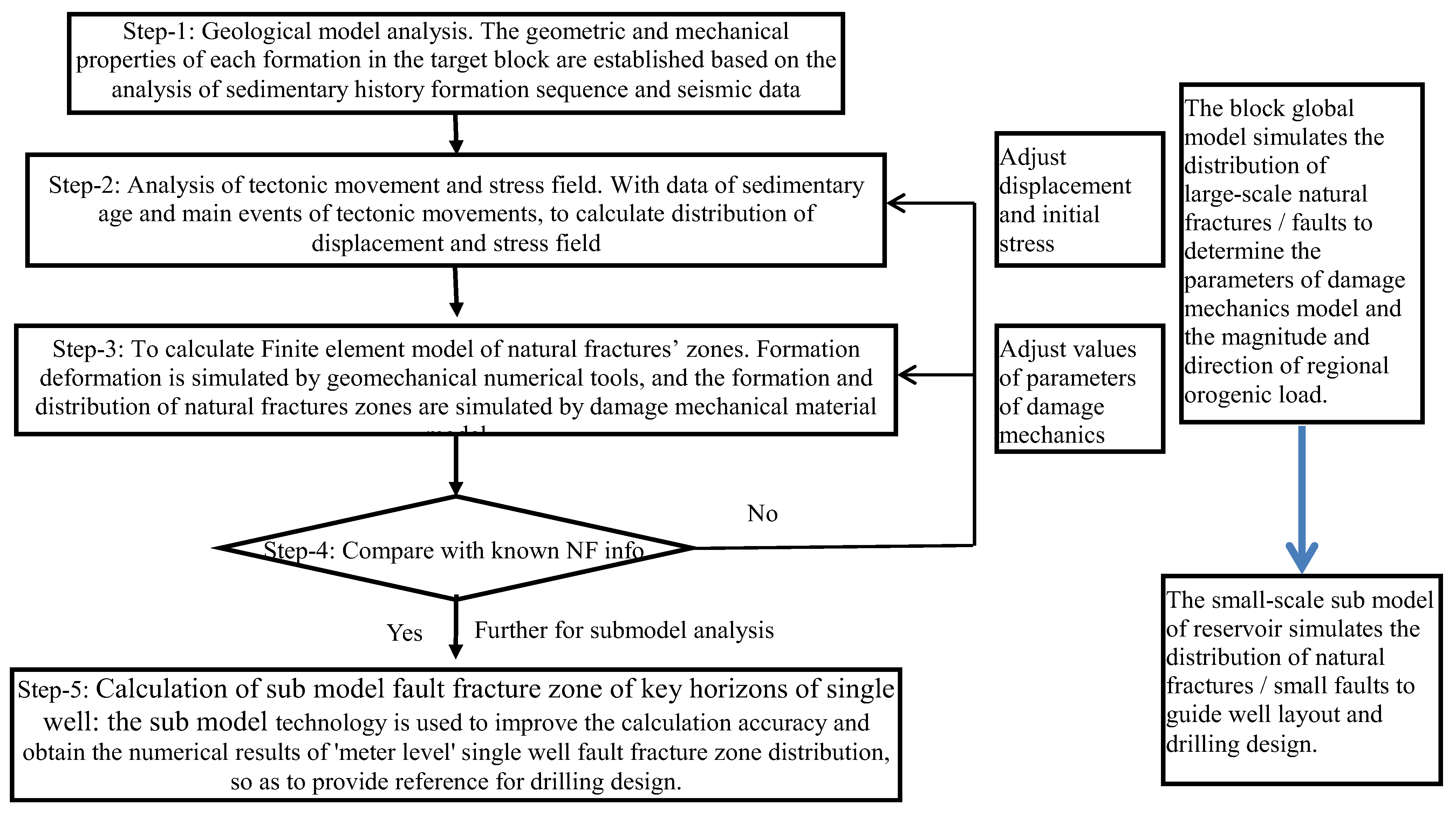
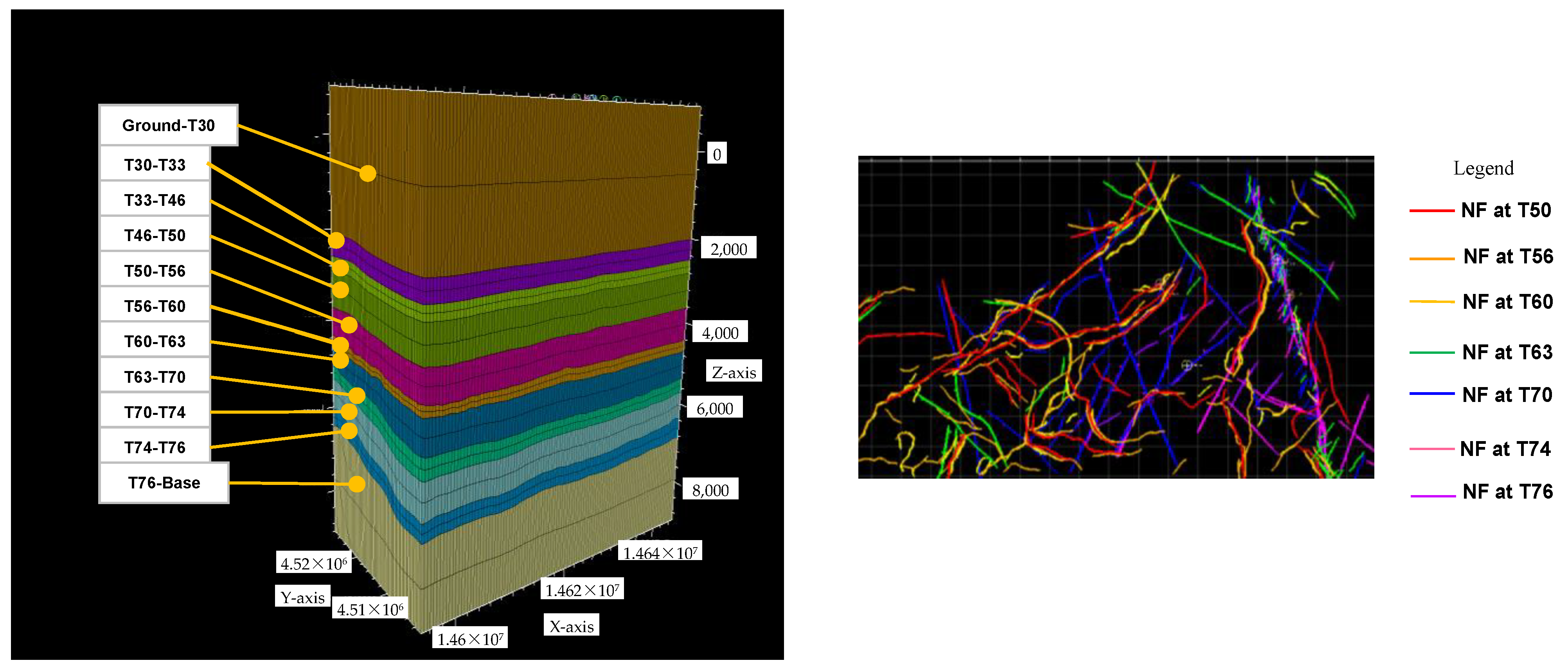

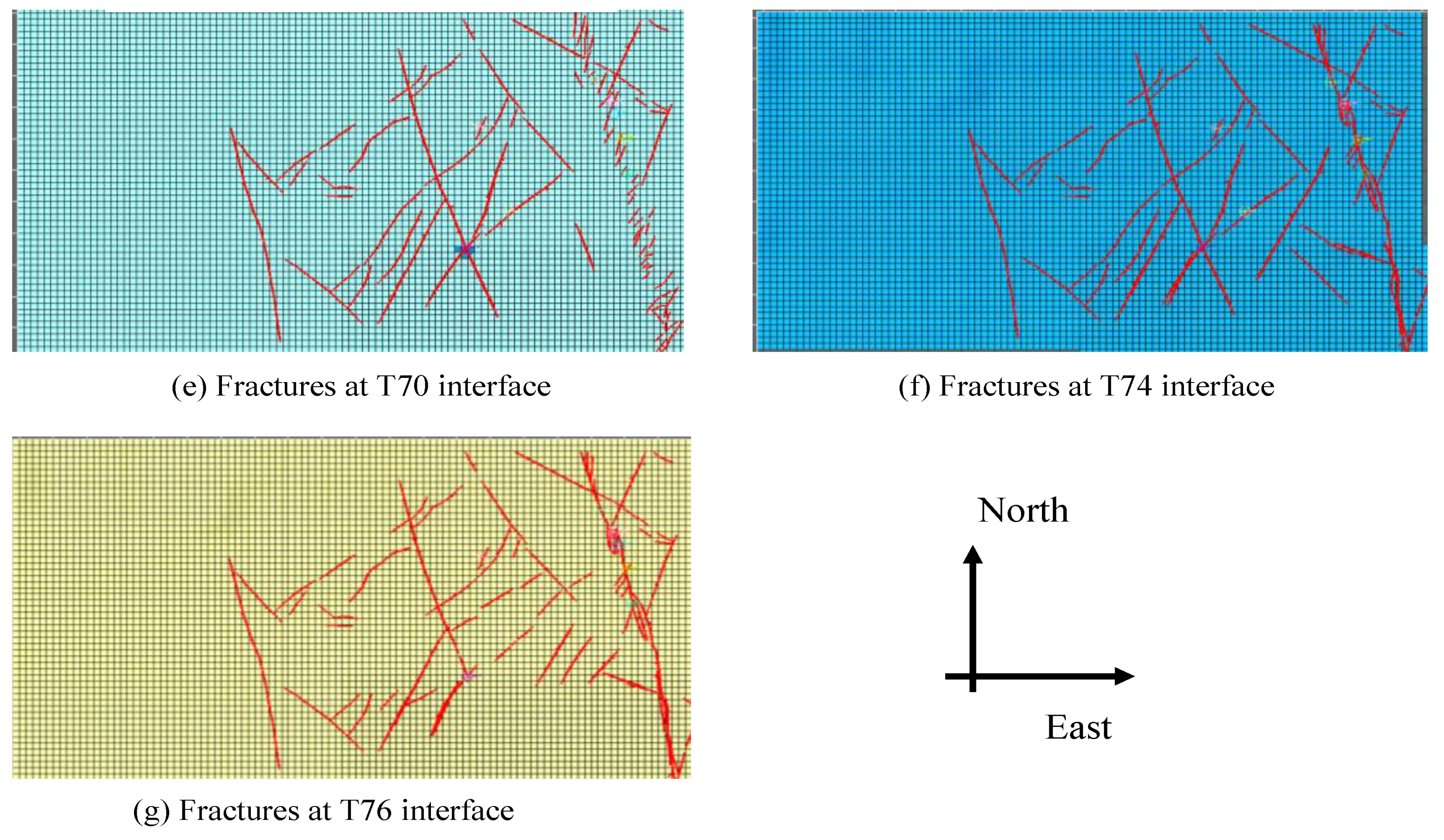
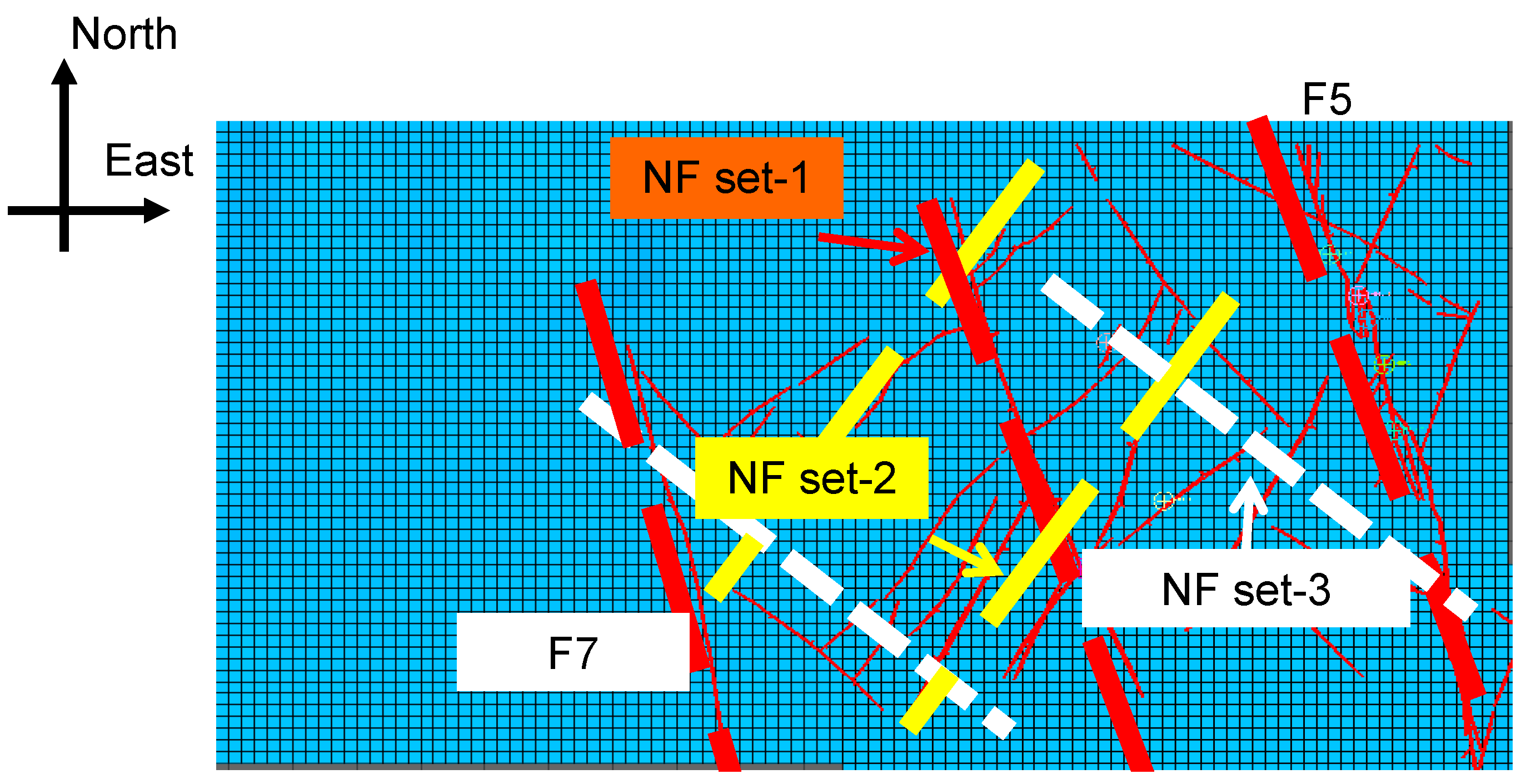

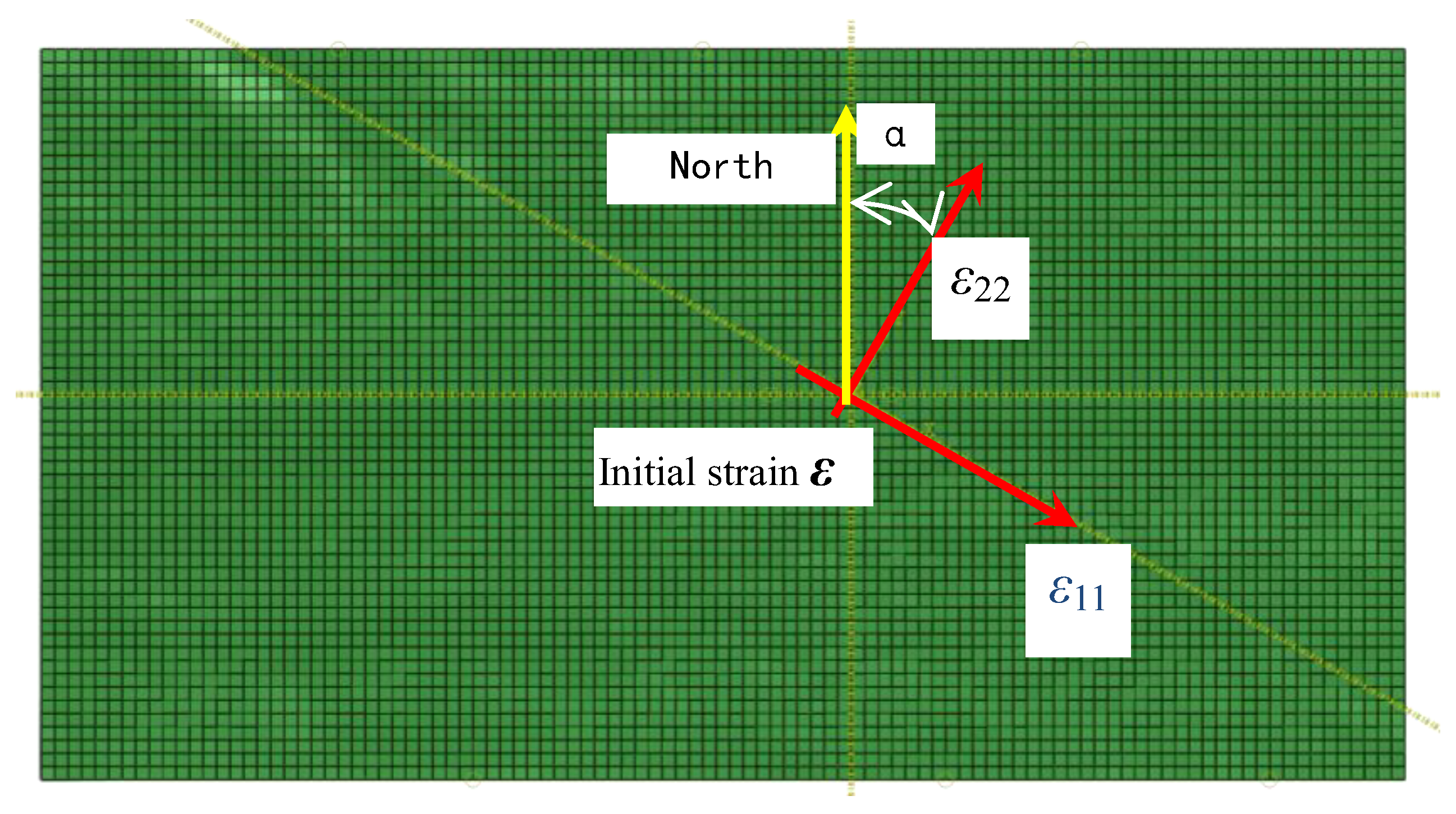

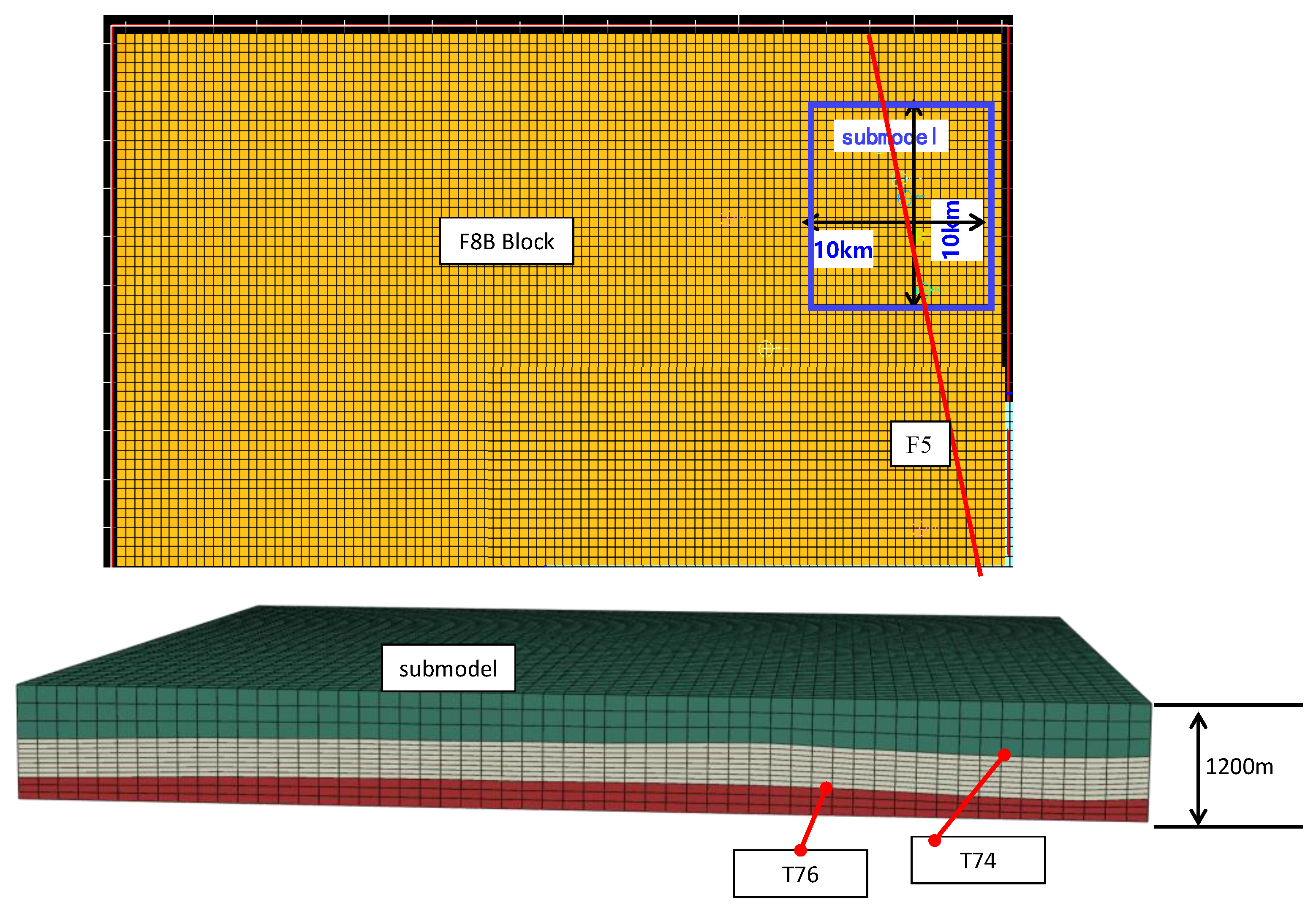
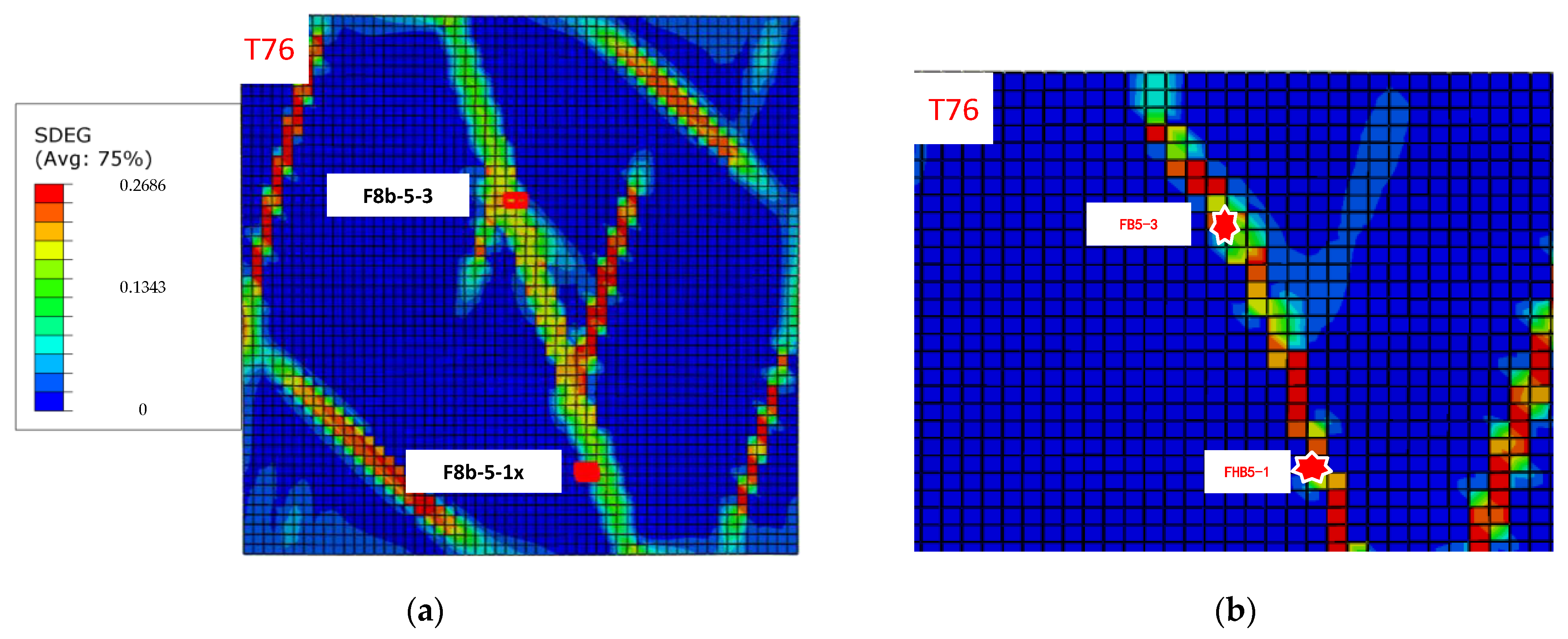
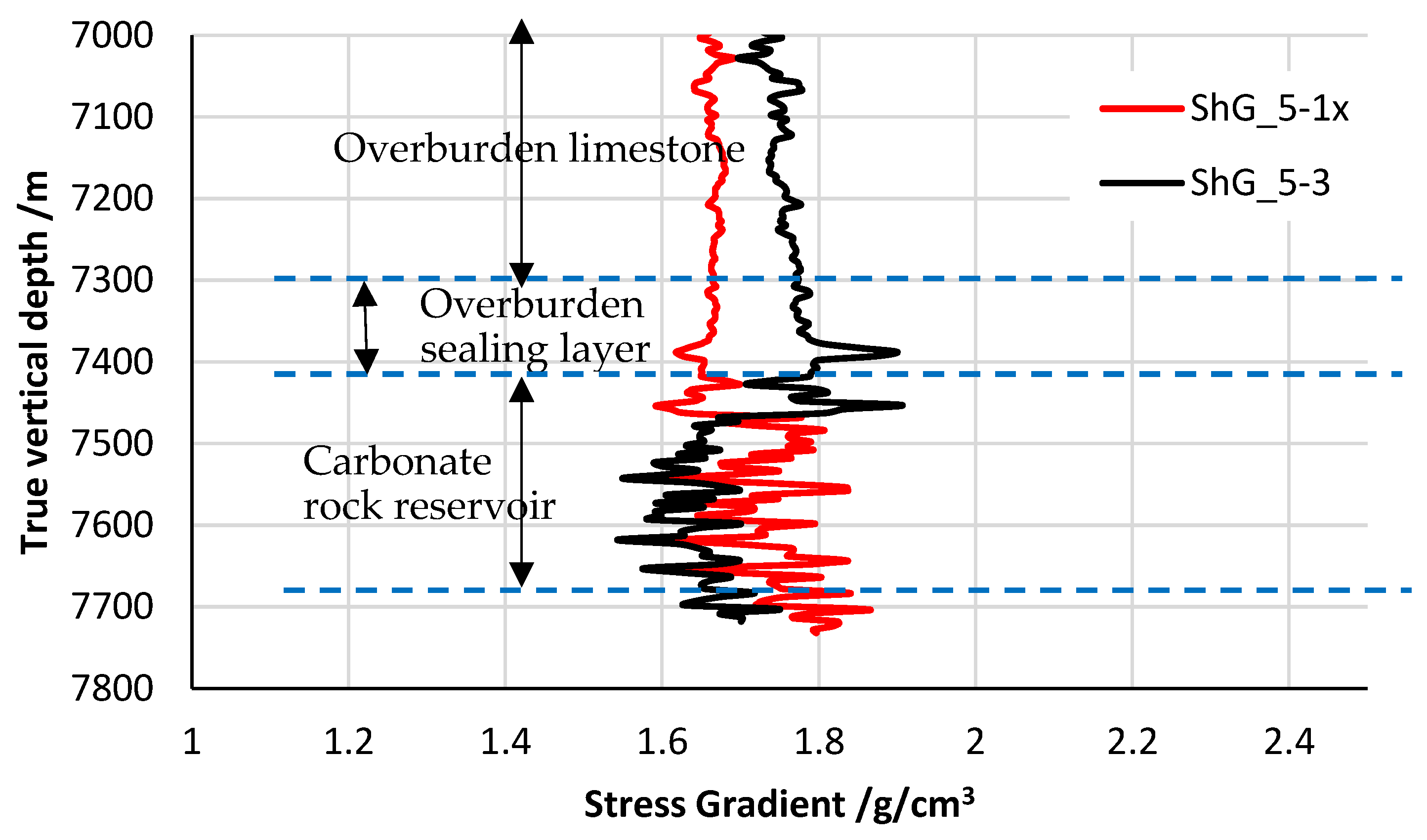
| Value of Dc | Values of εi |
|---|---|
| 0 | 0 |
| 0.0034 | 0.00012 |
| 0.05 | 0.003 |
| 0.25 | 0.01 |
| 0.27 | 0.05 |
| 0.45 | 0.055 |
| 0.46 | 0.1 |
| 0.5 | 0.11 |
| 0.75 | 0.5 |
| Value of Dt | Values of εi |
|---|---|
| 0 | 0 |
| 0.1 | 5 × 10−5 |
| 0.15 | 0.00015 |
| 0.7 | 0.0005 |
| 0.75 | 0.0015 |
| 0.9 | 0.002 |
| 0.905 | 0.5 |
Publisher’s Note: MDPI stays neutral with regard to jurisdictional claims in published maps and institutional affiliations. |
© 2022 by the authors. Licensee MDPI, Basel, Switzerland. This article is an open access article distributed under the terms and conditions of the Creative Commons Attribution (CC BY) license (https://creativecommons.org/licenses/by/4.0/).
Share and Cite
Yi, M.; Shen, X.; Jin, L.; Wang, J.; Huang, Z.; Shen, G. Forward Modeling of Natural Fractures within Carbonate Rock Formations with Continuum Damage Mechanics and Its Application in Fuman Oilfield. Energies 2022, 15, 6318. https://doi.org/10.3390/en15176318
Yi M, Shen X, Jin L, Wang J, Huang Z, Shen G. Forward Modeling of Natural Fractures within Carbonate Rock Formations with Continuum Damage Mechanics and Its Application in Fuman Oilfield. Energies. 2022; 15(17):6318. https://doi.org/10.3390/en15176318
Chicago/Turabian StyleYi, Ming, Xinpu Shen, Lixin Jin, Jianliang Wang, Zhiqiang Huang, and Guoyang Shen. 2022. "Forward Modeling of Natural Fractures within Carbonate Rock Formations with Continuum Damage Mechanics and Its Application in Fuman Oilfield" Energies 15, no. 17: 6318. https://doi.org/10.3390/en15176318
APA StyleYi, M., Shen, X., Jin, L., Wang, J., Huang, Z., & Shen, G. (2022). Forward Modeling of Natural Fractures within Carbonate Rock Formations with Continuum Damage Mechanics and Its Application in Fuman Oilfield. Energies, 15(17), 6318. https://doi.org/10.3390/en15176318





